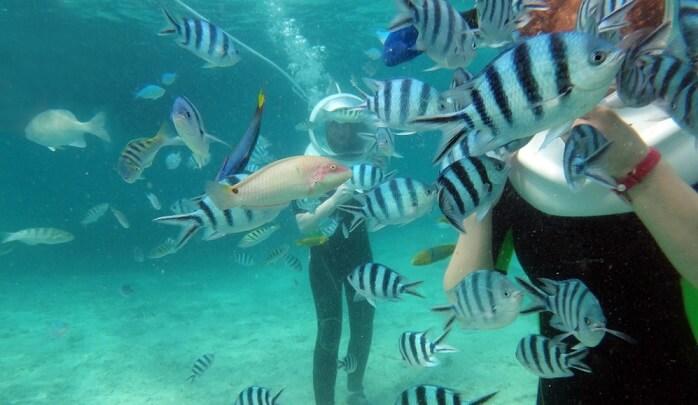70% of this beautiful planet that we call home is water and is home to some of the most beautiful creatures found on this orb. These magnificent creatures, each one unique in its own sense inhabit a world that is absent to the layperson. Well absent unless you have ever been diving or snorkeling!
So, have you ever snorkeled? Ever submerged your head under water and titillated your senses by viewing exotic marine life. The beautiful fish, their fins gently swaying in the swirling water; present a breathtaking display of nature that is a sight to behold.
Unlike what most people believe, snorkeling requires very little swimming. It’s a simple process of floating on the sea’s surface with a snorkel (the tube that you breathe air in through) and mask (to cover the face and primarily protect the eyes from saline seawater) strapped on. This is an activity that even non-swimmers can enjoy if they are able to take a few precautions.
Maldives, Indonesia, Philippines, Caribbean islands, Australia etc offer some of the best snorkeling destinations in the world on account of their coral reefs. However, although this seemingly benign activity comes with many delights, there are also a few precautions that you need to take before you embark on this sport.
So, here is a list of a few simple things to keep in mind before & when you go snorkeling:
- Choose a clear day – The most important thing when going snorkeling is to choose a clear day in which the ocean is not choppy. A choppy ocean will have a stronger wave current so you may have to try harder to stay afloat in one place. Also, choppy conditions will undoubtedly disturb the sand and the visibility under water may become poor. It will be difficult to view any marine life under such conditions.
- Chose the right swimwear– Some people are comfortable swimming in brief swimwear while others tend to feel comfortable in a full suit. Choose whatever you find comfortable and less inhibiting. But choose the suit based on the temperature of the water as time tends to slip away when you go snorkeling and you may end up spending more time in the water than you intended. A brief swimsuit would be a deterrent to this pleasure if the water is cold so choose wisely. Regardless of the suit chosen, do apply sunscreen if your skin tans/burns easily.
- Try on the equipment – Try on the snorkel and mask before hand and adjust them to the size of your face & head. If it’s not a god fit, then change it.
- Leave the flippers – If it’s your first time snorkeling then it is better not to slip on any flippers. Flippers are more for people who have some experience snorkeling and are able to float for longer periods or need to swim faster in the water. First time snorkelers swim in shallow waters and tend to panic if they are not able to reach the ocean bed and flippers would inhibit this. Since the best snorkeling is on or near coral reefs which have many sharp & jagged edges so it is advisable to wear some protective footwear. Rubber or PVC lightweight slip-ons are advisable as the craggy edges of the coral littering the ocean bed can give you a serious injury.
- Practice floating – If you can swim then snorkeling should not be an issue at all. However, if you cannot swim then do try to practice floating on the surface of the water before you strap on the mask & snorkel. In case you are not confident then it is advisable to wear a life jacket so that you can safely enjoy this activity.
- Study about what to expect – Study up about the local marine life so that you are able to identify the aggressive or dangerous species in the ocean. This is vital as not all species of fish that you encounter in the ocean would be friendly. Some of the seemingly benign species can be potentially the most dangerous like the sting ray, Moral eels, puffer fish etc. Hence, acquaint yourself with the hidden dangers before you venture into the water.
- Buddy up – If you are a first time snorkeler then it is a good idea to buddy up when you go snorkeling. Either go in a group or with another person so that you can keep an eye on each other. First time snorkelers tend to panic when they are unable to touch their feet on the ocean bed or when a large fish swims close by. In order to avoid any mishap on account of this panic, it is advisable to go with a buddy. Trust me, the fun in snorkeling doubles when you are able to show your findings to another person so take someone along.
- Control your breathing – It is vital that you control your breathing and not give in to panic or anxiety. Take deep and measured breaths under water as short breaths may aggravate your panic and may leave you feeling breathless. Do not try to gulp in air. Just relax! There is enough air coming in through the snorkel tube so just breathe in normally like you would on land.
- Do not splash about – If you splash about then you will scare all the fish away. So, stay calm & relaxed and let your body gently float above the marine life. If you feel tired then use gentle strokes to swim towards shore.
- Only watch, do not touch – The cardinal rule of the sea/ocean. When snorkeling, be an observer and do not disturb the marine life. Do not try to feed them at all or even extend your hand towards them. If you try to feed them underwater then you may be swarmed by a school of fish and they may nip at you, depending on the species. Most marine animals are only dangerous when they feel threatened or when they feel a need to defend themselves. Also, trying to touch them will only make them swim away from you or the more aggressive species may attack. So, just be an observer. You can of course record what you watch on underwater cameras.
Image – Mael BALLAND via unsplash
 Sonal Singh On Sonal's Table
Sonal Singh On Sonal's Table




